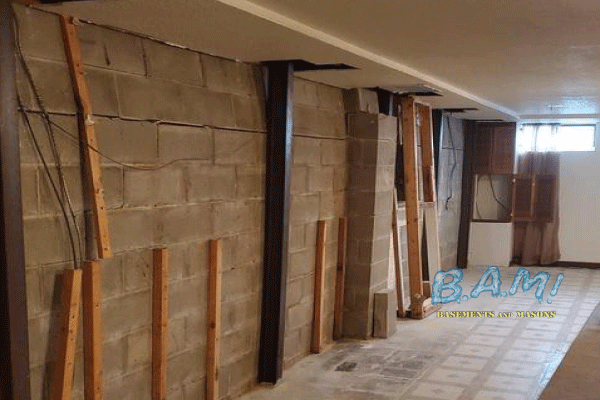The 7-Minute Rule for Best Basement Waterproofing
The 7-Minute Rule for Best Basement Waterproofing
Blog Article
Top Guidelines Of Best Basement Waterproofing
Table of ContentsGetting The Best Basement Waterproofing To WorkThe smart Trick of Best Basement Waterproofing That Nobody is DiscussingThe Main Principles Of Best Basement Waterproofing Top Guidelines Of Best Basement Waterproofing10 Easy Facts About Best Basement Waterproofing Described
AdvantaClean's skilled experts and service technicians will locate the water resource. If wall or slab fractures are existing, we will certainly inject polyurethane and epoxies into the splits and seal the concession, protecting against further dampness from getting in.Setting up basement air flow systems, conditioning systems, or cellar dehumidifier systems to obtain water out of your basement. Choosing AdvantaClean's cellar waterproofing solutions is an efficient means to treat moisture and prevent mold from compromising the structure of your home and the health of your household.
If there's condensation outside of the aluminum foil, you have high moisture in your cellar. Fix it with a mobile area dehumidifier or a whole-house humidifier system instead of waterproofing items. If the foil has condensation on the within surface area (next to the wall surface), the dirt around your home may be normally damp from a high water table or inadequate soil water drainage.
You can waterproof just your indoor wall surfaces, which may resolve the problem. Or you can waterproof your outside wall surfaces, which is a better wager yet even more costly. Here's the inside story on the various types: These thick finishings are cement-like. Once they dry out, they stick completely to concrete and masonry wall surfaces.
Our Best Basement Waterproofing Statements
Concrete water-proof layers can't be applied to previously repainted surface areas; check the label. Understood as densifiers, they are suitable just for walls that have not been painted or secured.
Yet you brush, roll, or spray it on much even more heavily one gallon covers just 75 square feet, not the 300 square feet typical with basic paint. Water resistant paint is great for do it yourself application. You can apply it over repainted surfaces, and paint over it once it's healed (one gallon prices $37).
It can set you back $10,000 to $15,000, relying on the work required. Outside waterproofing entails excavating all around your house to the complete depth of the structure walls, then mounting a waterproof covering or membrane layer covered by drainage panels. The panels give an easy path for water to flow to an exterior French drainpipe at the base of your foundation.
Things about Best Basement Waterproofing
We've all been caught in a storm without any umbrella or raincoat. And it's constantly a recipe for calamity: every little thing's wet, your hairstyle is spoiled, and things are getting moldy. A basement without waterproofing is sort of like that. Minus the destroyed hairdo part. Your cellar does not intend to experience a downpour without correct security just as high as you don't desire to.

Exterior waterproofing is a waterproofing approach that includes sealing your home from the exterior. It's kind of like a moat around a castle. It involves excavating a trench around your whole residence to the foundation (about 8 to 10 feet down). The foundation walls are after that cleaned up, sealed, and covered with a waterproof membrane or sealer.
What Does Best Basement Waterproofing Mean?
It's a much more engaged procedure that needs digging up your yard, which is costly and taxing. Exterior waterproofing involves getting rid of every little thing bordering the house, including go to my blog decks, driveways, sidewalks, landscape design, AC devices, decks, and more. If any one of the job was done improperly and water is still entering your basement, there isn't much you can do to correct or fix it.
Inside cellar waterproofing includes waterproofing from the within. Any kind of water that leakages right into your basement is redirected prior to it touches your floor. It's sort of like putting on a raincoat under your garments. It involves 2 points: a Read Full Report water drainage track and a sump pump. It works by sealing the within your basement walls and floorings so water that tries to get in is carried out via a sump pump.
It's an efficient method to water resistant your basement. The drawback of indoor cellar waterproofing mainly has to do with the setup process.
Not known Facts About Best Basement Waterproofing
To conclude, exterior and interior basement waterproofing are both effective methods of safeguarding your home from water damages. Outside waterproofing develops a barrier that stops water from entering your home, while indoor waterproofing redirects water that does enter your home. And it is essential to note that outside waterproofing is an expensive you can try this out and disruptive installation procedure when contrasted to interior waterproofing.
Whichever technique you choose, make certain you select a trusted and reliable specialist for the task. Both approaches need skilled workers to manage the job. If you have any kind of concerns concerning basement waterproofing, please get to out to us. And if you remain in our service area and have water in your basement, contact us for a cost-free, no-obligation home assessment.
You can load out our form here. Best Basement Waterproofing, begin a chat in the bottom right-hand corner, or call us at 1-800-827-0702
Report this page